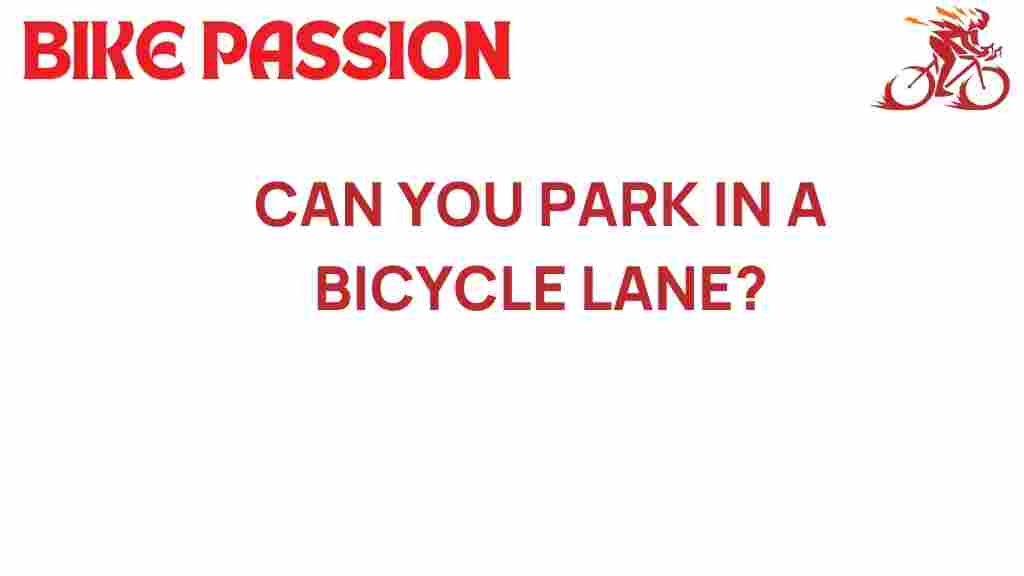Can You Park in a Bicycle Lane? The Surprising Truth Revealed
As urban mobility continues to evolve, cities around the world are prioritizing cyclist safety by implementing dedicated bicycle lanes. These lanes are designed to provide a safe space for cyclists, reducing the risk of accidents and promoting eco-friendly transportation. However, many drivers often wonder: can you park in a bicycle lane? This article will delve into the complexities of parking rules, traffic regulations, and the legal implications of parking in a bicycle lane, ensuring you understand the importance of respecting these spaces for the safety of all road users.
Understanding Bicycle Lanes
Bicycle lanes are designated portions of the roadway that are reserved for cyclists. They are typically marked with specific paint and signage, clearly indicating that these lanes should not be obstructed by parked vehicles. Understanding the purpose and function of bicycle lanes is crucial for all road users, as these lanes play a significant role in city planning and urban mobility.
- Increased Safety: Bicycle lanes are designed to keep cyclists safe from motor vehicle traffic.
- Encouraging Cycling: Well-designed bicycle infrastructure encourages more people to cycle, reducing traffic congestion.
- Environmental Benefits: Promoting cycling helps reduce carbon emissions and supports sustainable transportation.
Parking Rules and Traffic Regulations
Every city has its own set of traffic regulations regarding parking in bicycle lanes. In many urban areas, parking in these lanes is illegal and can result in fines or even towing. Here are some common rules regarding bicycle lane parking:
- Prohibition During Specific Hours: Some cities allow parking in bicycle lanes during certain hours or days.
- Loading Zones: In some areas, designated loading zones may be permitted, but they must be clearly marked.
- Exceptions for Emergency Vehicles: Emergency vehicles may be allowed to stop in bicycle lanes under specific circumstances.
It is essential to familiarize yourself with your local transportation regulations to avoid unlawful parking in a bicycle lane.
Legal Implications of Parking in a Bicycle Lane
Parking in a bicycle lane can lead to several legal consequences. Here’s what you need to know:
- Fines: The most immediate consequence is the potential for receiving a parking ticket. Fines can vary significantly by jurisdiction.
- Towing: In some cases, vehicles parked in bicycle lanes may be towed, leading to additional costs and inconvenience.
- Liability in Accidents: If an accident occurs because a vehicle was parked in a bicycle lane, the driver may be held liable for any injuries or damages.
Understanding these legal implications is vital for both drivers and cyclists to ensure a safer environment for everyone on the road.
A Step-by-Step Guide to Parking Legally
To ensure you are parking legally and responsibly, follow these steps:
- Check Local Regulations: Always review your city’s parking regulations regarding bicycle lanes. This information can usually be found on the local government or transportation department’s website.
- Look for Signage: Pay attention to any posted signs indicating whether parking is allowed in the bicycle lane.
- Consider Time Limits: Some areas may allow parking in bicycle lanes during off-peak hours. Be mindful of time restrictions.
- Utilize Designated Parking Areas: Whenever possible, use designated parking areas that do not interfere with bicycle lanes.
Troubleshooting Common Parking Issues
Here are some common issues drivers face regarding bicycle lane parking and how to troubleshoot them:
- Confusing Signage: If you encounter unclear or contradictory signs, contact your local transportation authority for clarification.
- Blocked Bicycle Lanes: If you see a lane blocked by parked cars, report it to local authorities to promote cyclist safety.
- Frequent Changes in Regulations: Cities often update their traffic regulations. Stay informed by subscribing to local updates or newsletters.
The Importance of Cyclist Safety and Urban Mobility
Understanding the relationship between bicycle lanes and cyclist safety is essential for promoting effective urban mobility. Here are some key points:
- Reducing Accidents: Properly designated bicycle lanes reduce the likelihood of accidents between cyclists and motor vehicles.
- Encouraging Sustainable Transport: By providing safe cycling options, cities can encourage more people to choose bicycles over cars, contributing to a greener environment.
- Enhancing Quality of Life: Cities that prioritize cycling infrastructure often see improved quality of life for their residents.
Ultimately, respecting bicycle lanes is vital for fostering a collaborative environment for all road users. For more information on urban cycling initiatives, check out this external resource.
Conclusion
In summary, parking in a bicycle lane is generally prohibited due to the significant implications for cyclist safety and urban mobility. Understanding parking rules, traffic regulations, and the consequences of illegal parking can help you navigate your city responsibly. As cities continue to evolve and prioritize safe transportation options, it is up to all road users to respect the designated spaces for bicycles, ensuring a safer environment for everyone.
For more insights on urban planning and transportation, feel free to explore our internal link on related topics.
This article is in the category Maintenance and created by BikePassion Team
